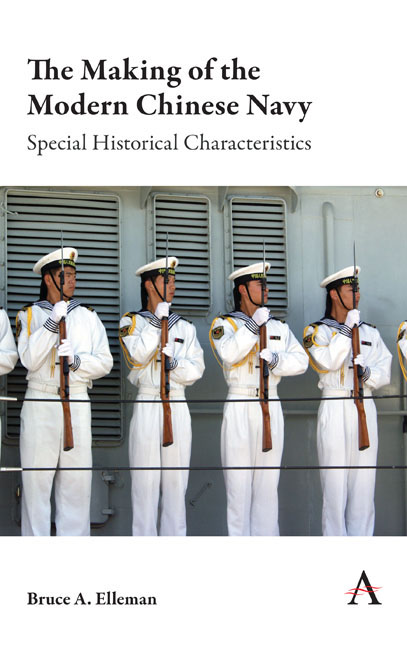Book contents
- Frontmatter
- Contents
- Introduction: The Special Characteristics of China's Maritime History
- 1 Battle of Bạch Đăng River (938)
- 2 Battle of Yaishan (1279)
- 3 Battle of Lake Poyang (1363)
- 4 Ming–Kotte War in Southeast Asia (1410–11)
- 5 Ming Loyalists Flee to Taiwan (1661–83)
- 6 Battle of Chuanbi (1839)
- 7 Sino-French War (1884–85)
- 8 Qing Beiyang Fleet's Defeat in the Battle of the Yellow Sea (1894)
- 9 Chinese Decision to Sink The Nationalist Navy as Blockships (1937)
- 10 Chongqing Mutiny Allowing the PLA to Cross the Yangzi River (1949)
- 11 The Taiwan Strait Crises (1954–55 and 1958)
- 12 China's Decision to Take the Paracel Islands from South Vietnam (1974)
- 13 Missile Blockade: The Taiwan Strait Crisis (1995–96)
- 14 The EP-3 Standoff and Diplomatic Resolution (2001)
- Conclusions: The Influence of History on the Formation of a Modern Chinese Navy
- Selected Bibliography
- Index
13 - Missile Blockade: The Taiwan Strait Crisis (1995–96)
Published online by Cambridge University Press: 04 October 2019
- Frontmatter
- Contents
- Introduction: The Special Characteristics of China's Maritime History
- 1 Battle of Bạch Đăng River (938)
- 2 Battle of Yaishan (1279)
- 3 Battle of Lake Poyang (1363)
- 4 Ming–Kotte War in Southeast Asia (1410–11)
- 5 Ming Loyalists Flee to Taiwan (1661–83)
- 6 Battle of Chuanbi (1839)
- 7 Sino-French War (1884–85)
- 8 Qing Beiyang Fleet's Defeat in the Battle of the Yellow Sea (1894)
- 9 Chinese Decision to Sink The Nationalist Navy as Blockships (1937)
- 10 Chongqing Mutiny Allowing the PLA to Cross the Yangzi River (1949)
- 11 The Taiwan Strait Crises (1954–55 and 1958)
- 12 China's Decision to Take the Paracel Islands from South Vietnam (1974)
- 13 Missile Blockade: The Taiwan Strait Crisis (1995–96)
- 14 The EP-3 Standoff and Diplomatic Resolution (2001)
- Conclusions: The Influence of History on the Formation of a Modern Chinese Navy
- Selected Bibliography
- Index
Summary
A naval show of force can have a dramatic impact. Almost 50 years to the day after the Potsdam Conference of July 16–August 2, 1945, resulting in the Potsdam Declaration of July 26, 1945, which reconfirmed the Cairo Declaration signed two years before stating that Taiwan should be returned to China, the PRC conducted six missile tests during July 21–26, 1995, in an area only 40 nautical miles north of Taiwan's Pengchiayu Island. These tests interfered with both sea and air traffic to-and-from Taiwan, and ignited international outrage. In March 1996, a second series of missile tests sought to influence Taiwan's presidential election. The second attempt also failed, however, and Lee Teng-hui became the first democratically elected president in all of Chinese history. China's actions have since been described as a “missile blockade.” They led to the intervention of two US Navy carrier battle groups in support of Taiwan.
Summary of the Taiwan “Missile Blockade” Crisis
The July 1995 missile tests by the PRC are often portrayed as a response to the granting of an American visa to Taiwan's president Lee Teng-hui for an unofficial visit to Cornell University in early June 1995. However, the real underlying concern for the PRC was over Taiwan's rapid democratization and the growing separatist claims by large numbers of Taiwanese. On July 18, 1995, China announced that ballistic missile tests would take place between 21 and 28 of July. These dates exactly corresponded with the fiftieth anniversary of the 1945 Potsdam treaty stating that China would regain all territories lost to Japan, including Taiwan, after World War II ended.
The PRC missile tests were intended to create an exclusion zone, in this case a ten-nautical-mile circle, in which ships and planes could not enter safely. This zone was located about 85 miles north of Taiwan, which was just outside Taiwan's sovereign waters but actively interfered with flight paths and shipping lanes. Six DF-15 (CSS-6/ M-9) short-range ballistic missiles (SRBMs) were fired, two each on July 21, 22, and 23, 1995. Beijing's announcement warned other states “against entering the said sea area and air space” during the firing period. These PRC missile tests diverted hundreds of commercial flights heading for Taipei.
- Type
- Chapter
- Information
- The Making of the Modern Chinese NavySpecial Historical Characteristics, pp. 63 - 68Publisher: Anthem PressPrint publication year: 2019



